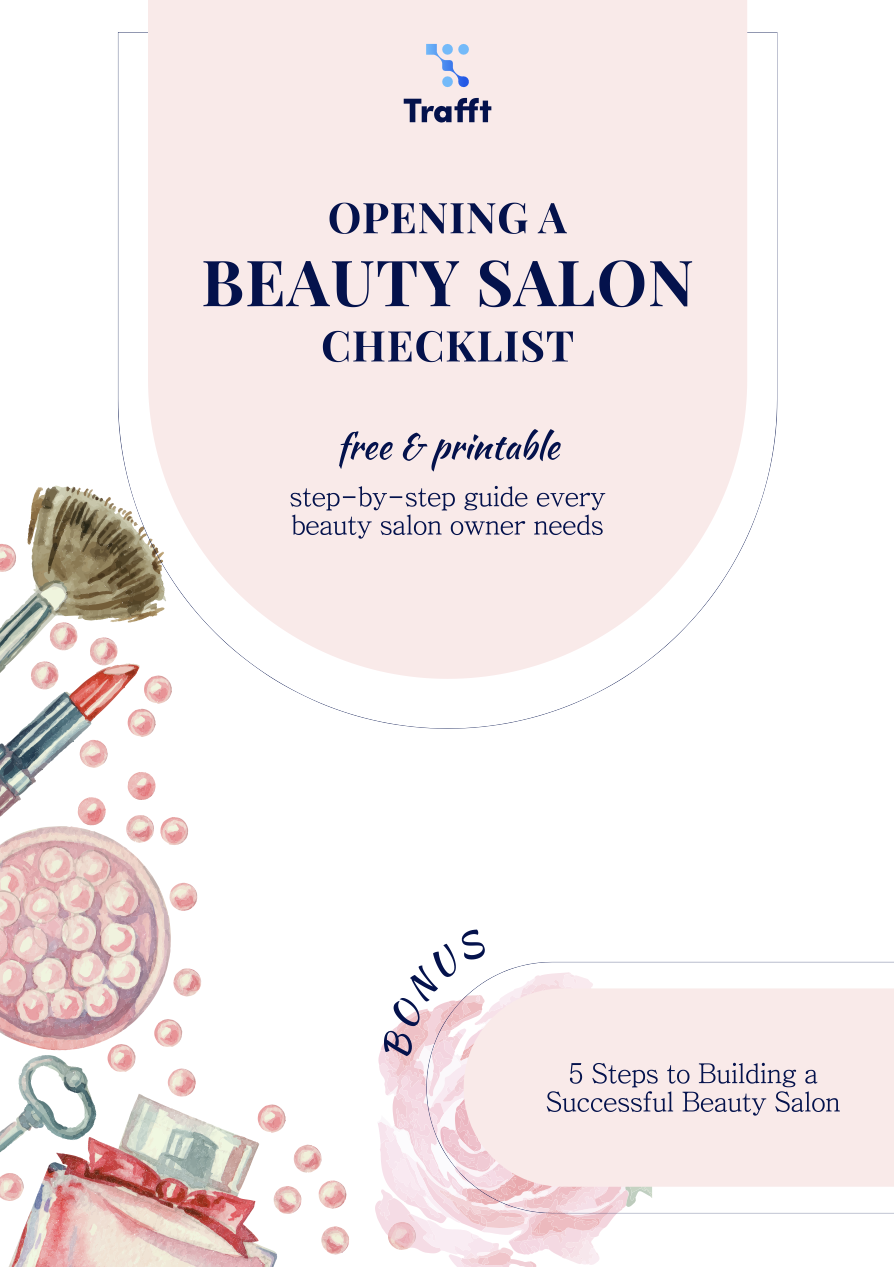You want to lead a modern, functional and organized salon business? Then, you need salon software to help you achieve these goals! But how much does salon software cost?
These digital solutions that automate appointment scheduling, client management, and inventory tracking will allow you to focus more on delivering quality service, rather than getting bogged down by administrative tasks.
But how much should you expect to pay for salon software? In this guide, we’ll break down the costs, explain what factors influence the price, and help you find a solution that fits your budget.
Why Invest in Salon Software?
Investing in salon software can transform the way you run your business. Here are some of the key benefits:
- Time-Saving: Automated booking and reminders reduce manual work, freeing up time for you and your staff.
- Improved Client Retention: Features like appointment reminders, loyalty programs, and follow-up messages keep clients engaged.
- Enhanced Customer Experience: Clients can book appointments online, access their service history, and make payments easily.
- Reduced No-Shows: Automated SMS and email reminders help minimize missed appointments, directly impacting your revenue.
- Centralized Management: Manage client data, track inventory, and monitor staff schedules—all from a single platform.
With all these advantages, it’s clear that salon software can be a game-changer. But how do you determine the right solution for your budget?
Factors That Influence the Cost of Salon Software
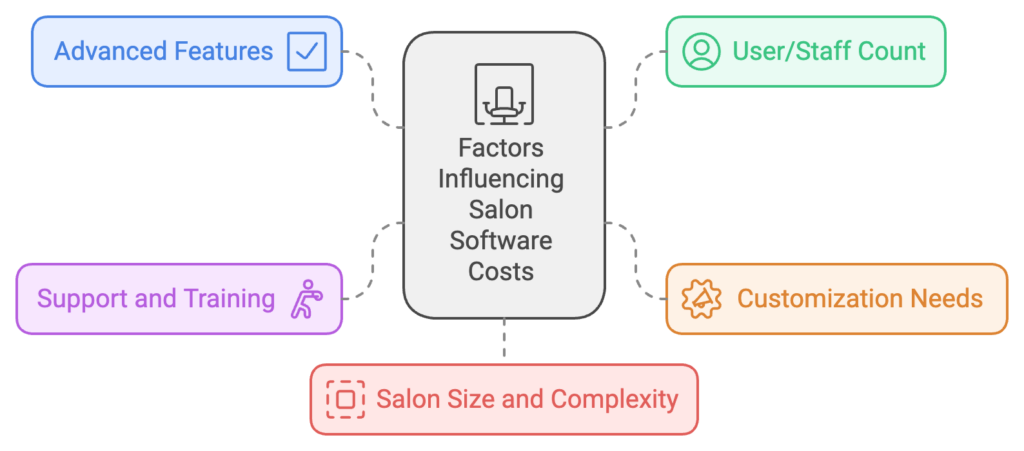
Several factors play a role in determining the price of salon software.
Firstly, the more advanced features a software offers, the higher its price tends to be. For instance, software that includes online booking, payment processing, automated marketing, and detailed reporting will typically cost more than a basic scheduling tool.
Next, many software solutions charge based on the number of users or staff members who need access. A small salon with just a few employees may pay less than a large, multi-location business with numerous staff members needing access.
Some salons require custom features or integrations with other tools, such as accounting software, CRMs, or inventory management systems. Customization can add to the cost but may be essential for businesses with specific needs, such as salons.
Additionally, opting for a software solution that offers dedicated customer support, training sessions, or onboarding assistance can impact the cost. These services ensure you get the most out of the software but may come with additional fees.
Finally, pricing often varies based on the size and complexity of your salon. Solo stylists might find affordable options designed for their needs, while larger salons with multiple locations may need more robust and expensive software.
Pricing Models for Salon Software
Let's go over the different pricing models typical for salon software:
- Subscription-Based Pricing: Most salon software solutions follow a subscription-based pricing model, charging a monthly or yearly fee. This plan is popular because it typically includes updates, support, and access to new features as they are released. Basic plans might start around $10-$20 per month, while premium plans can reach $100-$200+ per month.
- One-Time Payment Models: Some platforms allow you to make a one-time payment for lifetime access to the software. This can be a cost-effective choice for those who want to avoid recurring fees, but it’s important to consider whether updates and support are included or require additional costs.
- Freemium Models: Some software providers offer a free plan with basic features and the option to upgrade to a paid plan for access to more advanced functionalities. Freemium models can be a good starting point, especially for new salons, but may have limitations such as fewer booking slots or restricted access to premium features.
- Per-Appointment or Commission-Based Pricing: A few platforms charge based on the number of appointments booked through their system or take a percentage of revenue generated through the software. This model can be attractive for those with low appointment volumes but might become expensive as your business grows.
Thank you for subscribing. Check your mail for details
Average Costs of Popular Salon Software Solutions
To give you an idea of what to expect, let’s look at the pricing of a few popular salon software options:
Basic salon software: Best for small salons on a budget
Low-priced salon software is aimed at small businesses and those that are just starting out. These software often have limitations in terms of features, are often a bit buggy, and are better options for solopreneurs, since they can’t support small to mid-sized businesses.
Visibook
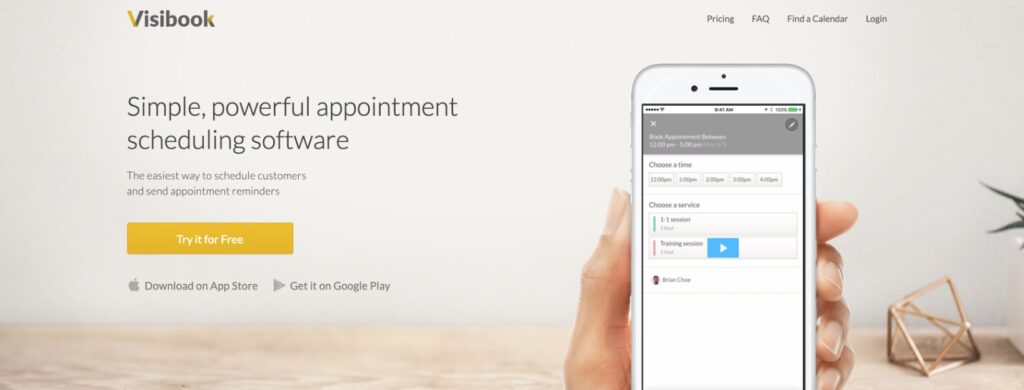
Visibook is a great software for starters and new business owners. Their plans are charged based on the number of your monthly appointments.
Every plan includes appointment features, automated reminders, individual or group appointments, customer management tools, and tools for business support and operations - just some of them are deposits and credit card payments.
Visibook is a great software for small businesses or solo entrepreneurs.
Pricing:
- Up to 25 appointments per month for free
- Up to 50 appointments per month for $6.99
- Up to 100 appointments per month for $13.99
- Unlimited appointments per month for $19.99
Rosy
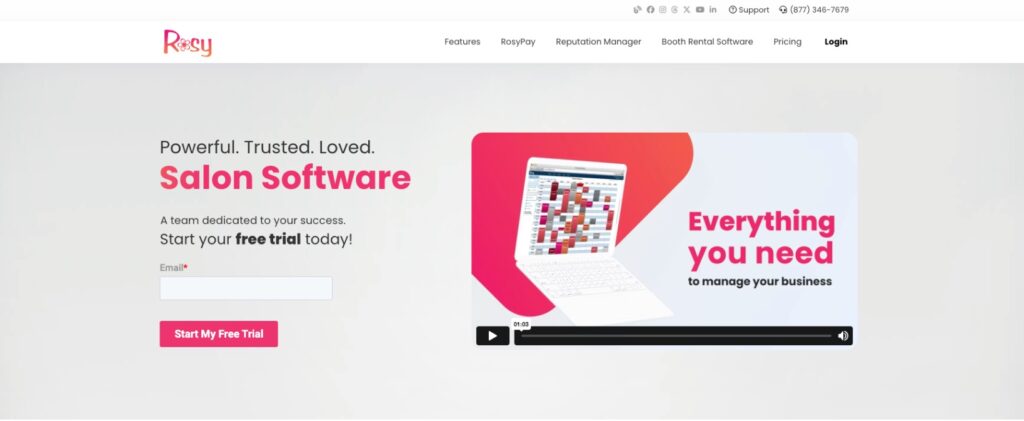
Rosy is another beginner-friendly salon software, both when it comes to its price, and its simplicity of use. Equipped with features such as 24/7 client booking, automated communication, credit card processing, and inventory management, Rosy will certainly ensure smooth day-to-day operations.
This salon software’s price is made for those who want comprehensive tools, but are mindful of their budget.
Every plan has a set of features that will accommodate small businesses, but as the price goes up, you get more awesome features. It costs $39 a month, for one user. The more users you have, the more pricey this software will be.
Rosy also offers a free trial.
Fresha
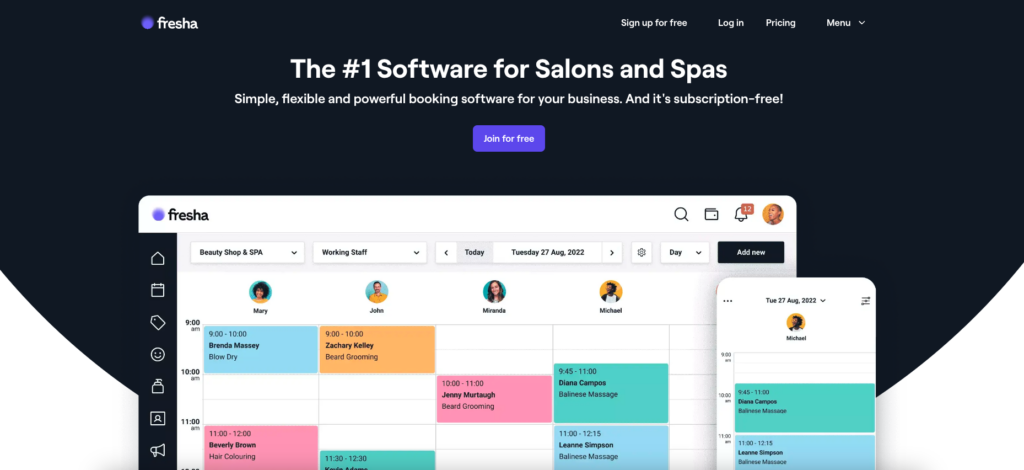
Fresha has an interesting pricing strategy. It doesn't have any subscription fees, but every time a transaction has been made, or when new clients find you on the Fresha marketplace, you do pay.
With its POS features, you can easily handle sales, manage client checkouts, and process payments with ease. With Fresha, you get all features for free, as well as unlimited appointment bookings, team members, unlimited locations, product inventory and much more.
Fresha is extremely budget-friendly for starters or small salons that want to minimize upfront costs while still utilizing a full-featured salon management platform.
Balanced salon software: Striking a balance between features and price
Mid-range priced salon scheduling software is for those who need more advanced features and scalability than what budget options offer, without the hefty price tag of premium software.
No matter if you’re just starting out your salon, or you’ve been running it for a while, you can benefit from the following software solutions greatly.
Trafft

Trafft is a salon booking software solution known for its ease of use and comprehensive features.
With Trafft you get a dedicated booking page, sync with Google Calendar, iCal, and Outlook to avoid double bookings, automated SMS, email, and WhatsApp reminders, secure online payments, an admin dashboard from where you can manage employees and appointments, and much more.
Check out all Trafft’s features that are specifically designed to boost your business, and lift the administrative burden off your shoulders!
The best part is, Trafft is suitable for both new salon owners, and established salons. It is FREE for up to 5 users, and the paid plan starts at $23.20 per month. With each plan, you get more cool features such as recurring appointments, deposit payments, custom domain, and much more!
Compare Trafft’s plans and pricing, and find the one that best fits your needs!
Amelia
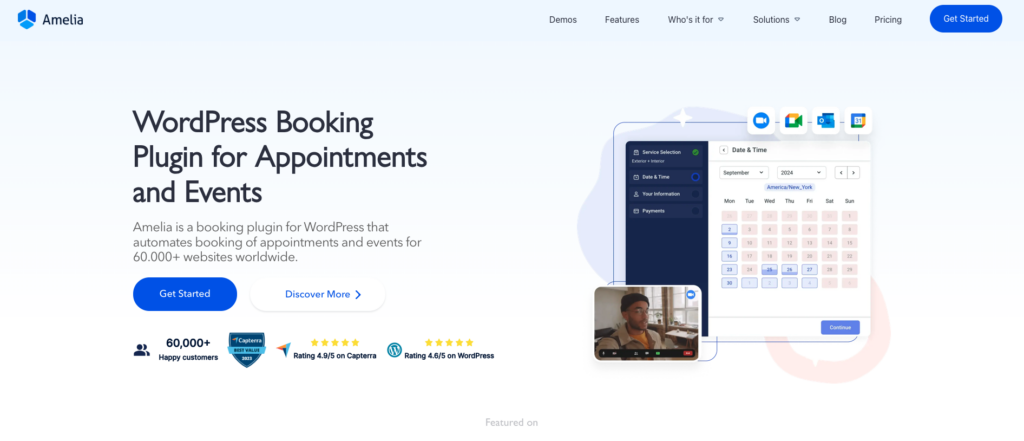
Amelia is a WordPress plugin, perfect for growing salons that require advanced scheduling and marketing tools.
Apart from customizable booking forms, a client-friendly booking page, and staff management features, Amelia also offers service packages, an insightful dashboard, and integrations with multiple online payment systems.
Plus, Amelia’s integration with Google Analytics and Facebook Pixel will help you monitor and improve your marketing efforts, ensuring that you can effectively track user interaction and optimize your promotional strategies.
This salon software’s price starts at $49 a year, with more advanced packages that offer you more features and multiple domains. Discover all Amelia’s pricing plans and choose one for you!
High-end salon scheduling software: Suitable for full-service salons
High-end salon software is for established businesses seeking to maximize efficiency and elevate their client experience with advanced technological tools. However, these tools tend to be too pricey for some businesses, since their costs often keep adding up. Plus, they also have a steep learning curve, because of so many features and options they offer.
Zenoti
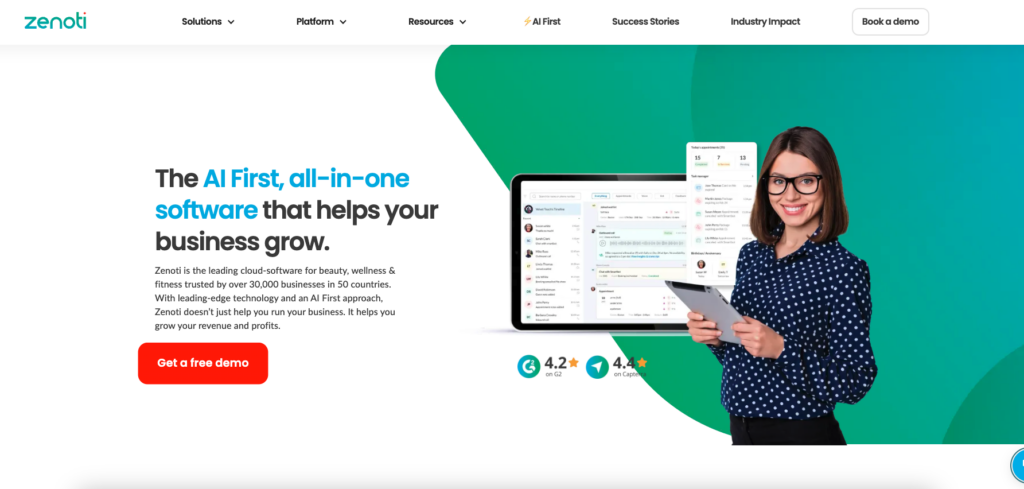
Zenoti is known for helping beauty salons manage employees, schedules, and appointments. It provides detailed performance analytics, so you can easily track individual employee performance through metrics such as client feedback, sales contribution and service delivery.
Zenoti also simplifies payroll - you can very easily track tips, hours, and commissions, and generate payroll reports automatically.
Zenoti’s price starts at $200 a month and has no free trial.
Mindbody

Mindbody is for those looking for extensive marketing features, membership management, and detailed reporting. It offers a comprehensive set of tools that support salons in expanding their clientele and maximizing retention through sophisticated integration and analytics capabilities.
Just some of Mindbody’s features include creating employee schedules, managing payroll with ease, and monitoring metrics such as sales, customer feedback, and service efficiency.
Mindbody offers four pricing plans, ranging from $129 to $699 per month, with various features in each pricing plan.
Hidden Costs to Watch Out For
When choosing salon software, you should keep an eye out for costs that might not be so obvious at first glance.
Some providers charge extra for setup and initial training. Make sure to clarify if these costs are included in the subscription or come at an additional fee. Also, if your software includes payment processing, check the rates for card transactions. Fees can vary between providers and add up over time.
Certain features, like SMS reminders or advanced marketing tools, might come as paid add-ons. Consider what features you actually need before opting for them.
And don't forget that connecting the software to other platforms like accounting software or a CRM may cost you extra.
How to Choose the Right Salon Software for Your Budget
Finding the right software requires balancing your needs and budget. Here’s how to choose wisely:
- Identify Your Needs: Make a list of must-have features and those that are nice to have. Focus on solutions that align with your business size and growth plans.
- Evaluate Software Options: Take advantage of free trials or demos offered by most providers. This will help you test out the user experience and see if it meets your requirements.
- Read Customer Reviews: Look for feedback from other salon owners, particularly those with similar-sized businesses. This can provide insights into the software’s ease of use and customer service.
- Consider Long-Term Value: While some software may seem costly upfront, it could save you time and money in the long run through improved efficiency and customer retention.
So, How Much Does Salon Booking Software Cost?
Selecting the right salon software can make a significant difference in how you manage your businesses, whether you’re just starting out or seeking to enhance an established operation.
Mid-range priced solutions like Trafft and Amelia will be the right choice in any case. Both options show that you don’t need to compromise on quality for affordability, making them an excellent choice for your salon.
Both platforms are designed to cater to the needs of solopreneurs, mid-sized salons, and even large chains or franchises, offering scalability and a suite of features that support growth!


